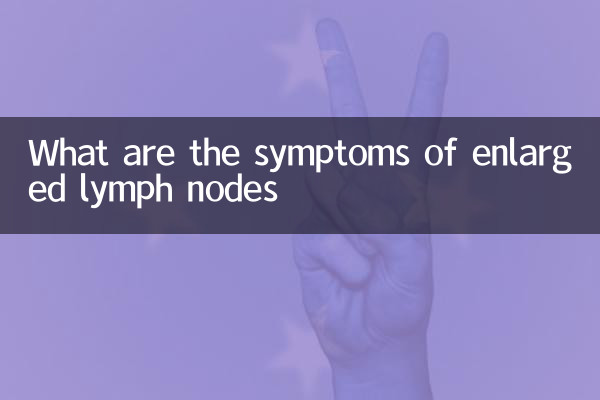What are the symptoms of enlarged lymph nodes
Swelling of lymph nodes is a common response to infection, inflammation, or other diseases of the body. Understanding its symptoms can help identify potential health problems in a timely manner. The following are the popular topics and structured data on lymph node swelling across the network in the past 10 days.
1. Common symptoms of lymph node enlargement

| symptom | describe | Possible Causes |
|---|---|---|
| Local swelling | Palpable lumps appear on the neck, armpits, or groin. | Infection, inflammation, tumor |
| Pain or tenderness | Feeling pain or discomfort when touched | Acute infection (such as bacterial or viral infection) |
| Redness or fever in the skin | Skin on the surface of swollen lymph nodes is red or temperature rises | Local inflammatory response |
| Systemic symptoms | Fever, fatigue, night sweats, weight loss | Systemic infection or immune disease |
2. Classification and characteristics of lymph node enlargement
According to duration and development speed, lymph node enlargement can be divided into the following two categories:
| type | Duration | Features |
|---|---|---|
| Acute swelling | Several days to 2 weeks | Often accompanied by pain, mostly caused by infection |
| Chronic swelling | More than 4 weeks | It may be painless, beware of diseases such as tumors or tuberculosis |
3. Danger signals that need to be vigilant
The following conditions may indicate serious illness and seek medical treatment in time:
| Red flags | Possible disease associated |
|---|---|
| Lymph nodes grow rapidly or have a diameter of more than 2cm | Lymphoma, metastatic cancer |
| Hard texture, fixed and inactive | Malignant tumors |
| Accompanied by long-term fever and night sweats | Tuberculosis, HIV infection |
4. Recent hot topics
1.Swelling of lymph nodes after viral infection: Influenza is prevalent recently, and many patients have reported that lymph nodes continue to enlarge after recovery, which has attracted attention.
2.COVID-19 vaccine and lymph node enlargement: Some vaccinated patients have swollen axillary lymph nodes, and experts have clarified that it is a normal immune response.
3.Common causes of enlarged lymph nodes in adolescents: EB virus infection (infectious mononucleosis) has become the focus of discussion.
V. Diagnosis and treatment suggestions
If lymph nodes are found to be enlarged, it is recommended:
| step | content |
|---|---|
| Preliminary observation | Record size, quantity, texture changes |
| Blood test | Routine blood, inflammation indicators, specific antibody detection |
| Imaging examination | Ultrasound, CT or MRI (if necessary) |
| Pathological biopsy | Perform when the patient continues to enlarge or suspected malignancy |
6. Prevention and daily precautions
1. Maintain good oral hygiene and prevent local infections such as gingivitis.
2. Treat respiratory infections in a timely manner to avoid repeated irritation of lymph nodes.
3. Pay attention to lymph node changes and avoid excessive compression or irritation of swollen areas.
4. Enhance immunity, maintain a regular schedule and a balanced diet.
Swelling of lymph nodes may be a health alert from the body, but is mostly associated with a mild infection. By observing the characteristics and duration of symptoms and combining with medical examinations, the causes can be clarified and targeted measures can be taken. If the symptoms persist or worsen, be sure to seek medical treatment in time.

check the details

check the details